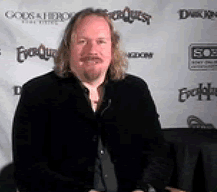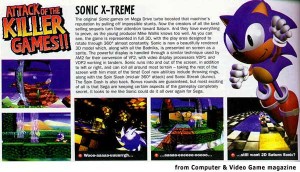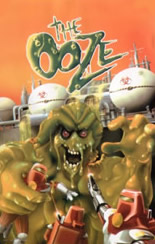You can’t be a PC gamer and not know the name Stieg Hedlund. He got his start in the industry working on the Commodore 64, Macintosh, and Amiga. After working at Koei and Electronic Arts, Hedlund joined Sega, where he worked on such games as Comix Zone and The Ooze for the  Genesis, as well as Die Hard Arcade for the Saturn. In 1996, he joined Blizzard Entertainment, where he was the lead designer for two of the most popular PC games ever made: Starcraft and Diablo II. Eventually, Hedlund left Blizzard and did some work for Ubisoft, where he was instrumental in the creation of many of its Tom Clancy’s series, including coming up with the concept for Ghost Recon: Advanced Warfighter.
Genesis, as well as Die Hard Arcade for the Saturn. In 1996, he joined Blizzard Entertainment, where he was the lead designer for two of the most popular PC games ever made: Starcraft and Diablo II. Eventually, Hedlund left Blizzard and did some work for Ubisoft, where he was instrumental in the creation of many of its Tom Clancy’s series, including coming up with the concept for Ghost Recon: Advanced Warfighter.
Most recently, Hedlund is working on a PC MMORPG with Perpetual Entertainment called Gods and Heroes: Rome Rising, set in the mythology-rich environment of ancient Rome. Sega-16 was able to tear him away from his hectic schedule for a bit of reminiscing about the good ol’ days at Sega.
Sega-16: How did you get your start at Sega?
Stieg Hedlund: I had actually worked for a couple of other game companies before I got to Sega, including Koei and Electronic Arts. So I’d worked on a lot of games that were PC native, but had also done plenty of ports, and worked on one Genesis-native title as well, my experience living and working in Japan was also compelling, not only because Sega was a Japanese company, but also since many of the STI guys were transplants from Japan. So, I was a pretty good “catch” for them, but I’d also heard that STI was a studio with a lot of impressive talent, so I was quite interested in them as well.
Sega-16: The Sega Technical Institute was created to beef up the American side of Sega’s software development. How open was Sega to new ideas from new designers? How much freedom to be creative were you given?
Stieg Hedlund: Interestingly, we were given a great deal of freedom within STI to explore new ideas, but the first step in greenlighting was a Wednesday lunchtime product-review session that comprised all of SOA. This meeting presented the progress of third-party projects and then allowed new projects to be showed. It was rather like swimming with sharks in well-chummed waters. Everyone was always in a very critical and negative mood by the time new projects were discussed, so it was often difficult to get significant buy-in. Despite what ever happened in those meetings, Shinobu Toyoda could still give you the go ahead.
Additionally the atmosphere encouraged presentations that were all surface and no substance, since there was no time or forum to go into depth. We became adept at creating MTV-style smash-cut videos.
The strength of the studio was with projects like Die Hard Arcade, where we didn’t need to go through this unpleasant process, and got carte blanche since it was technically an AM1 game. A bunch of those guys came over to the States to work with us and get it done, and there was an extremely dynamic cross-pollination that took place.
Sega-16: Was everything green lighted by Sega of America, or did Sega of Japan have any say in what was developed?
Stieg Hedlund: SOJ had some say—we’d send our designs to them for assessment. I think it was Comix Zone that came back with a note saying that it “embodied everything that was wrong with American culture,” which we accepted as high praise. They never had veto power, though, and only made recommendations.
Sega-16: Comix Zone is a great game that truly deserves a sequel. Any idea why this hasn’t happened yet?
Stieg Hedlund: That’s a question that gets asked a lot. Essentially the core of the team first became STI south, in the LA area and after some differences in creative direction went on to form the nucleus of Luxoflux, which later was acquired by Activision. We were also working at the time to move away from the 2D sidescrollers that had been our bread and butter to that point to 3D stuff like Die Hard Arcade. The premier franchise for STI was, of course, Sonic and a lot of work was being done on how that could transition to 3D in the ill-fated Sonic X-treme.
Sega-16: Who came up with the concept?
Stieg Hedlund: It was a guy named Peter Morawiec. We didn’t have very many designers at STI—basically one or two on a title, so we were guys with very strong vision, and Peter fit that mold exactly. His initial presentation of the game was a video that he mocked up that looked exactly like the game did when it was finished.
 Sega-16: The creative comic book-style gameplay of Comix Zone has never really been copied, which makes the title really unique. Do you think this type of gameplay could be successfully translated to a 3D engine? We’ve seen too many 2D games try and fail before. Could it be done?
Sega-16: The creative comic book-style gameplay of Comix Zone has never really been copied, which makes the title really unique. Do you think this type of gameplay could be successfully translated to a 3D engine? We’ve seen too many 2D games try and fail before. Could it be done?
Stieg Hedlund: I think it could be done, but it would be a challenge. The central conceit of the game is to play with the similarity between side-scrolling games to the flow of a comic book page, so you’d lose some of that by going 3D, but I don’t think that means it can’t be done by any means.
Sega-16: The Ooze suffered from being released in the shadow of new hardware (the Saturn) and thus received no marketing. Thankfully, it’s been given a second chance on several Sega compilations. Why do you think Sega has decided to bring it back now? Do you think they realize that they kind of missed the boat with it when it first debuted?
Stieg Hedlund: We created a really innovative game, but the focus had really shifted to the Saturn games at that point, so nobody really marketed the game at all. The packaging was ugly and the text was insipid, and The Ooze needed a little bit of explanation, since it was so far from “flavor-of-the-month.” People would look at it and be like, “Whoa, what is that?”, but while The Ooze is based on a pretty complex idea—the main character is a cellular automaton made of viscous liquid—we worked really hard to make it user-friendly and intuitive to play. Our marketing team didn’t want a challenge; they wanted to tell an easy story, and it doesn’t get any easier than a hot new platform launch.
Sega had decided at some point that their business model was that they were primarily a hardware manufacturer and that they made games to sell the hardware. I think this was remarkably shortsighted in addition to entirely overlooking what had put them on the map. It did result in some fantastic hardware—the Dreamcast had better-looking stuff on it until about the third generation of games on PS2 and Xbox hit, but Sega had used up its stock of good faith with developers starting with the 32X, and there was little left after the Saturn and Sega CD. I think the higher-ups decided we were an entertainment company at some point as well—we went pretty far afield, designing Sega amusement parks and working on the script for a Sonic movie. Since then Sega has of course focused exclusively on being a software maker and publisher.
Fortunately, the fans aren’t concerned with what windmills corporations are titling at, and especially in the Internet age word of mouth is a powerful thing. Things that are well-hyped but suck can’t succeed, and sleepers can get the recognition they deserve. We knew we were making something great, and it’s fantastic to see this cult resurgence.
Sega-16: Is it true that it was supposed to have been packaged with the Nomad?
Stieg Hedlund: We were, in fact, supposed to be bundled with the Nomad when it came out, but it was, as they say, a day late and a buck short. The Nomad was ahead of its time in a sense, since it was more advanced than other handhelds, but without continued development of titles for it, it couldn’t really be viable.
Sega-16: Have you ever had any ideas for a possible revisit to these games?
Stieg Hedlund: Even before The Ooze was finished, the lead Programmer, Dave Sanner, had figured out how to translate an ooze algorithm into 3D. It’s still quite different from anything out there
(Katamari Damacy is vaguely similar in that the “character” can absorb objects in the environment—for us it was creatures—to gain more mass), so I’m not sure it wouldn’t feel really innovative and cool in today’s market. It’d be a challenge, but I like challenges.
Sega-16: Sega supposedly had a bunch of titles in various stages of development when the Genesis was discontinued. Any particular ones come to mind?
 Stieg Hedlund: The Ooze, Comix Zone and a game that got cut, but was tentatively called Segapede were the last titles STI concepted for the Genesis. Even Sonic X-treme was conceived as a 32X title initially, though it moved through various incarnations to the Saturn and the super-secret (and unreleased) Saturn V08 we were working on for awhile with Nvidia. Our focus was very much on moving to 3D ever since AM2 made the first Virtua Fighter game. (Ed. note: For more information on Sonic Xtreme, head on over to Xtreme artist and designer Chris Senn’s site, where there is a ton of goodies like videos, music, and more!)
Stieg Hedlund: The Ooze, Comix Zone and a game that got cut, but was tentatively called Segapede were the last titles STI concepted for the Genesis. Even Sonic X-treme was conceived as a 32X title initially, though it moved through various incarnations to the Saturn and the super-secret (and unreleased) Saturn V08 we were working on for awhile with Nvidia. Our focus was very much on moving to 3D ever since AM2 made the first Virtua Fighter game. (Ed. note: For more information on Sonic Xtreme, head on over to Xtreme artist and designer Chris Senn’s site, where there is a ton of goodies like videos, music, and more!)
It was a hard transition for a lot of folks, and there were a lot of concepts that died on the vine. Among others there was a 3D RTS “lite” design that I collaborated on with Hirokazu Yasuhara, that Pikmin wound up looking eerily similar to years later.
Sega-16 wishes to thank Mr. Hedlund for his time, as well as Chris Launius for all his help in making this interview possible.

Pingback: Gráficos Retro: Sega Saturn – Disruptive Ludens